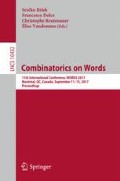Abstract
Palindromic length of a word is defined as the smallest number n such that the word can be written as a product of n palindromes. It has been conjectured that every aperiodic infinite word has factors of arbitrarily high palindromic length. A stronger variant of this conjecture claims that every aperiodic infinite word has also prefixes of arbitrarily high palindromic length. We prove that these two conjectures are equivalent. More specifically, we prove that if every prefix of a word is a product of n palindromes, then every factor of the word is a product of 2n palindromes. Our proof quite naturally leads us to compare the properties of palindromic length in free monoids and in free groups. For example, the palindromic lengths of a word and its conjugate can be arbitrarily far apart in a free monoid, but in a free group they are almost the same.
Access this chapter
Tax calculation will be finalised at checkout
Purchases are for personal use only
References
Allouche, J.P., Baake, M., Cassaigne, J., Damanik, D.: Palindrome complexity. Theoret. Comput. Sci. 291(1), 9–31 (2003)
Bardakov, V.G., Gongopadhyay, K.: Palindromic width of finitely generated solvable groups. Comm. Algebra 43(11), 4809–4824 (2015)
Bardakov, V.G., Shpilrain, V., Tolstykh, V.: On the palindromic and primitive widths of a free group. J. Algebra 285(2), 574–585 (2005)
Blondin Massé, A., Brlek, S., Labbé, S.: Palindromic lacunas of the Thue-Morse word. In: Proceedings of GASCom, pp. 53–67 (2008)
Borchert, A., Rampersad, N.: Words with many palindrome pair factors. Electron. J. Comb. 22(4), P4.23 (2015)
Brlek, S., Hamel, S., Nivat, M., Reutenauer, C.: On the palindromic complexity of infinite words. Int. J. Found. Comput. Sci. 15(2), 293–306 (2004)
Bucci, M., Richomme, G.: Greedy palindromic lengths (Preprint). http://arxiv.org/abs/1606.05660
Fici, G., Gagie, T., Kärkkäinen, J., Kempa, D.: A subquadratic algorithm for minimum palindromic factorization. J. Discrete Algorithms 28, 41–48 (2014)
Fink, E.: Palindromic width of wreath products. J. Algebra 471, 1–12 (2017)
Frid, A.E., Puzynina, S., Zamboni, L.Q.: On palindromic factorization of words. Adv. Appl. Math. 50(5), 737–748 (2013)
Glen, A., Justin, J., Widmer, S., Zamboni, L.Q.: Palindromic richness. Eur. J. Comb. 30(2), 510–531 (2009)
Guo, C., Shallit, J., Shur, A.M.: On the combinatorics of palindromes and antipalindromes (Preprint). http://arxiv.org/abs/1503.09112
Holub, Š., Müller, M.: Fully bordered words. Theoret. Comput. Sci. 684, 53–58 (2017)
I, T., Sugimoto, S., Inenaga, S., Bannai, H., Takeda, M.: Computing palindromic factorizations and palindromic covers on-line. In: Kulikov, A.S., Kuznetsov, S.O., Pevzner, P. (eds.) CPM 2014. LNCS, vol. 8486, pp. 150–161. Springer, Cham (2014). doi:10.1007/978-3-319-07566-2_16
Ravsky, O.: On the palindromic decomposition of binary words. J. Autom. Lang. Comb. 8(1), 75–83 (2003)
Author information
Authors and Affiliations
Corresponding author
Editor information
Editors and Affiliations
Rights and permissions
Copyright information
© 2017 Springer International Publishing AG
About this paper
Cite this paper
Saarela, A. (2017). Palindromic Length in Free Monoids and Free Groups. In: Brlek, S., Dolce, F., Reutenauer, C., Vandomme, É. (eds) Combinatorics on Words. WORDS 2017. Lecture Notes in Computer Science(), vol 10432. Springer, Cham. https://doi.org/10.1007/978-3-319-66396-8_19
Download citation
DOI: https://doi.org/10.1007/978-3-319-66396-8_19
Published:
Publisher Name: Springer, Cham
Print ISBN: 978-3-319-66395-1
Online ISBN: 978-3-319-66396-8
eBook Packages: Computer ScienceComputer Science (R0)

